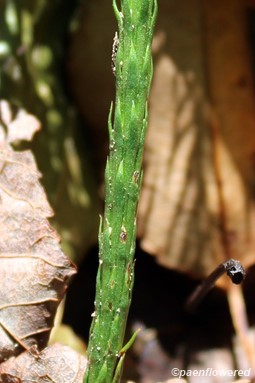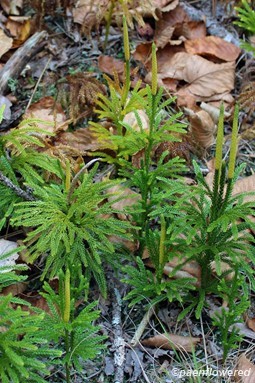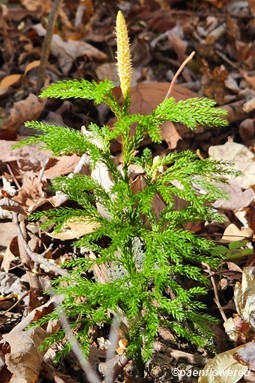Dendrolycopodium obscurum
Small plant that looks like a tiny pine tree
Dendrolycopodium obscurum princess pine
Add to MyPlants View Locations
A small, treelike, evergeen clubmoss with many spreading, flattened branches and lustrous green leaves. The plant has a distinctive appearance resembling miniature pine trees, making it an attractive ground cover in shaded, forested areas. Common in our area and mostly found in humus-rich woods.
Habitat & Range
Common in rich hardwood and mixed forests, and shrubby areas; moist to dry, acidic soils.
Range: From Newfoundland south to PA and to southeast VA, Kentucky and west to Minnesota.
| EMP: | FACU |
|---|---|
| NCNE: | FACU |
Phenology
This clubmoss overwinters.
Characteristics
Horizontal stems creeping and branching well below surface of ground; no annual constrictions.
Upright stems to 12 in. tall. Erect, treelike; branched 4-5 times to form fanlike lateral branches. Tightly appressed leaves on main stem below lateral branches. Stems arise at intervals from subsurface horizontal stem.
Lateral branches somewhat flattened in cross-section, with leaves on underside very small. Conspicuous annual constrictions.
Leaves 1/4 in. long. Narrow, lance-shaped; smooth sides taper to sharp-pointed tips. All leaves ascend(pointed toward end of branch); leaves of lateral branches 6-ranked.
Strobilus 1.5 in. long. Sessile (no stalk), borne singly on ends of upper branches, 1-6 per upright, branche stem.
Sporophyll rouned, glat base and long, gradually narrowing tip.
Identification Tips
The stem has a tree-like appearance. The leaves are dark green, needle-like, and appressed to the stem.
Plant Codes
S-rank: S5 (Secure)
G-rank: G5 (Secure)
APG/Taxonomization Info
The epithet 'obscurum' was given to the plant by Linnaeus in 1753. It comes from the latin word, obscurus meaning "to hide".
Dendrolycopodium obscurum princess pine
Synonyms: Lycopodium obscurumAdd to MyPlants View Locations














Comments
Have you spotted this plant in your area? We'd love to hear about your experience! Share your comments or questions about the plant below. Comments are moderated before posting.